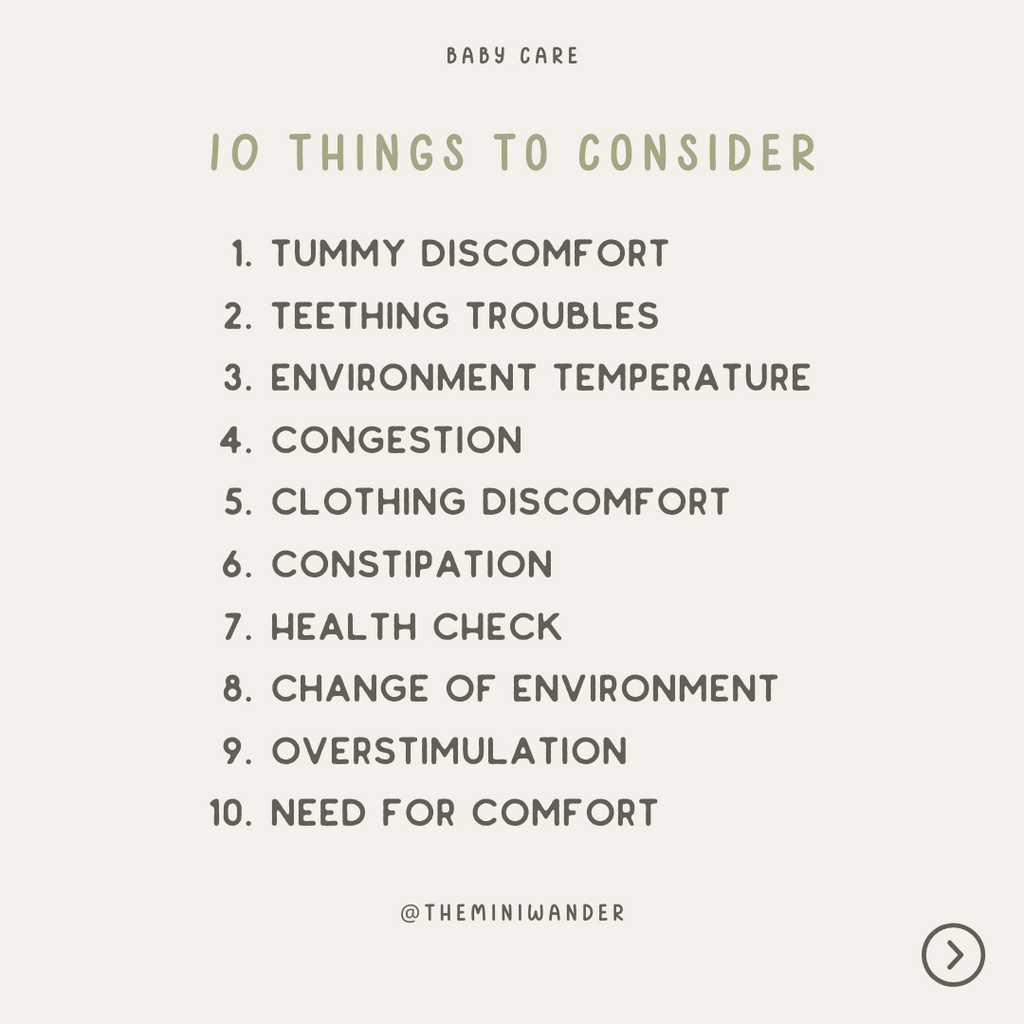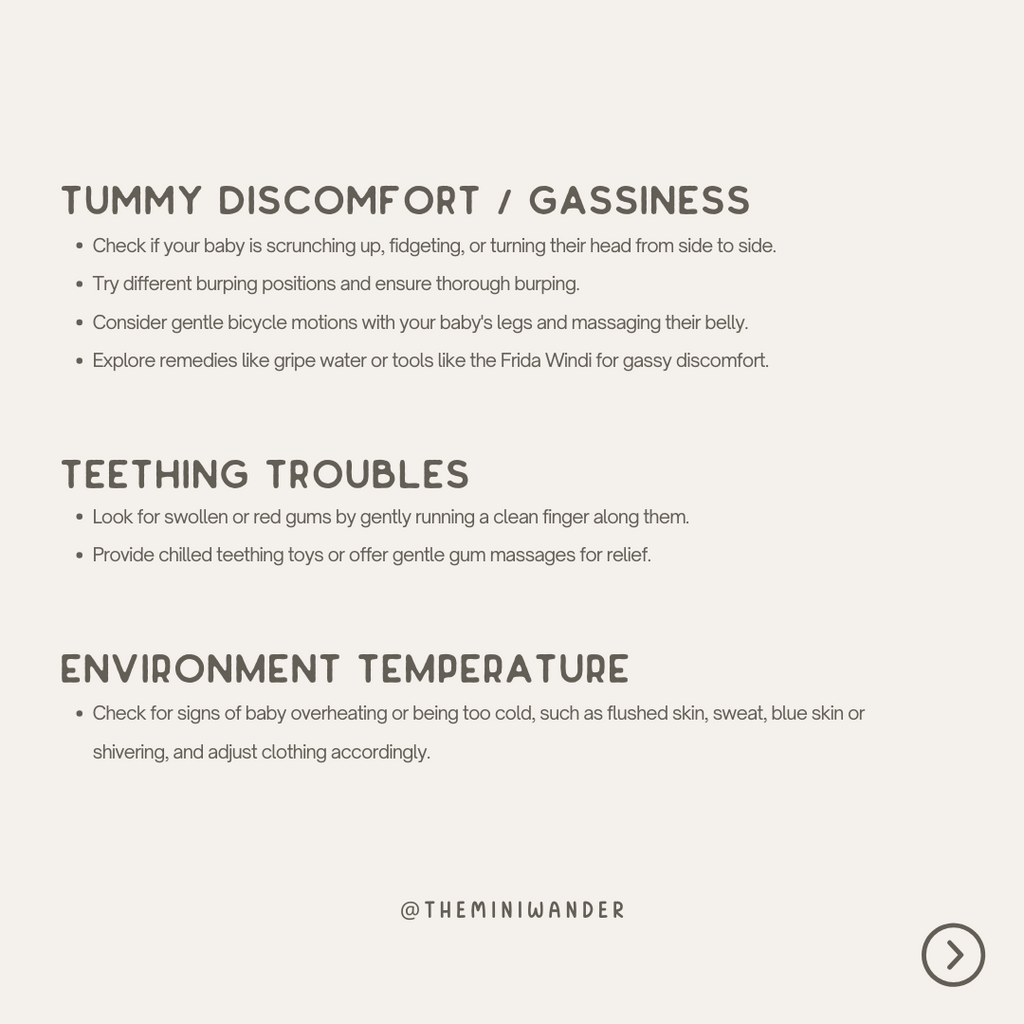Why Is My Baby Crying After Feeding and a Diaper Change?
Hello, parents! If you've ever wondered, 'Why is my baby crying after feeding and a diaper change?' you're not alone. I've connected with amazing moms on Instagram, delving into their wealth of experience. Together, we'll unravel the mystery and share valuable insights. Drawing from my Instagram community, primarily composed of moms, I sought their perspectives on what might be causing their babies to cry despite having their basic needs met. This article compiles their invaluable advice into actionable steps for new parents, offering a troubleshooting guide for those moments when your crying baby seems unsettled. Let's dive into the collective wisdom and find solutions together to help care for your baby.
The Basics - Feeding and Diaper Change
Sometimes a baby can cry for hours. You might think to yourself “My baby won't stop crying and I've tried everything” When that happens, it might be a good idea to step away for a few minutes. After you take a few deep breaths, come back and start from this list. It is a sort of a troubleshooting guide. First things first, the feeding and diaper changes – the dynamic duo every parent becomes intimately acquainted with. Even if you just fed them or changed them, sometimes the answer might be as simple as they are still hungry or in need of another diaper change.
Feeding Needs:
Hunger is often the first reason a baby cries. Even if you recently fed them, they might be going through a growth spurt, so the solution might be as straightforward as another feeding. If your baby is going through a growth spurt, they might be cluster feeding and need extra nutrition.
Look for hunger cues such as rooting, wrist-sucking, or increased alertness. Your baby's subtle signals can guide you in understanding their needs.
For a more in-depth guide on baby feeding, check out our article here.
Diaper Change Reminder:
Don't forget to double-check for diaper changes. Even if you recently changed them, babies can surprise you. I recall a humorous moment when changing my daughter; she managed to go through three diapers in one session! Babies have a knack for keeping us on our toes. Double check to see if they have any signs of a rash. Slightly reddened skin can be itchy and cause your baby to be uncomfortable, preventing them from settling down.

Insights from Moms: Why Babies Cry After Basics Are Covered
Alright, you've fed your baby, changed their diaper, and yet, the excessive crying persists. What might you have missed? Let's uncover the mysteries together with this checklist, curated from the invaluable advice of fellow moms. Lets dive into these insights to explore potential solutions and discover what might be lingering beneath the surface when your little one seems fussy and inconsolable.

1. Gassiness and Tummy Discomfort:
Given their delicate bodies and the need for frequent feedings, babies can sometimes feel uncomfortable with the aftermath. If you observe your little one scrunching up, fidgeting with their arms and legs, or turning their head from side to side, these subtle cues may indicate that your baby is experiencing gas or might need assistance in burping.
Burping a Baby
Experiment with different positions to facilitate burping, and remember that even after a big burp, your crying baby might require more burping. Some babies, due to factors like reflux, may need extra attention in this regard.
Gassiness Solutions
For gassiness, consider incorporating exercises such as gentle bicycle motions with your baby's legs and massaging their belly. Additionally, gripe water is a mom-approved remedy for easing gassy discomfort. Explore helpful tools like the Frida Windi designed to address gassiness effectively. Many mamas said this tool can be a game-changer in providing relief for your little one.
2. Teething Troubles:
Teething can be a challenging phase for both babies and parents. Check for swollen or red gums by gently running a clean finger along your baby's gums. Applying gentle pressure can help identify if the baby is experiencing discomfort. If your little one is teething, consider these practical solutions:
Chilled Teething Toys:
Provide a clean, chilled teething toy for your fussy baby to gnaw on. The coolness can help soothe sore gums. Silicone or rubber teething rings can be a comforting option for your baby to chew on.
Gentle Gum Massages:
Use a clean finger to gently massage your baby's gums. This can provide relief and ease teething discomfort.
3. Temperature Regulation:
Is your baby feeling just right or might they be too hot or too cold? Keep an eye out for signs of discomfort and adjust their outfits accordingly.
Check if your baby is too hot:
Ensure your baby is dressed appropriately for the temperature. Signs of overheating may include flushed skin, sweating, or feeling hot to the touch. If you notice these signs, consider dressing your baby in lighter clothing and adjusting the room temperature.
Checking if your baby is too cold:
On the other hand, signs of your baby being too cold can include shivering, cold fingers, toes or nose, or unusually pale or purple skin. If your baby shows these signs, consider adding layers or providing a warmer environment.
By staying attentive to your baby's cues, you can create a comfortable environment that helps keep them content and cozy.

4. Congestion Issues:
Tiny noses sometimes need a little help. A clogged nose is uncomfortable, it prevent your baby from being able to sleep comfortably and from being able to eat. Discover mom-approved methods for safely clearing congestion, making each breath a little easier for your little one.
Clearing with Nasal Aspirator or Bulb Syringe:
Provide relief by gently suctioning mucus with a nasal aspirator (like NoseFrida) or a bulb syringe. After each use, ensure a thorough cleaning for hygiene and effectiveness.
To enhance the effectiveness of suctioning, simultaneously consider using a saline solution. A gentle spray can help loosen mucus, making it easier to suction and providing relief to your baby. If your baby is sick, always clear the airway with this method before each feeding and before putting your infant to sleep.
Elevating the Head:
If congestion is a concern, elevate your baby's head slightly during sleep. This simple adjustment can ease breathing, particularly effective during nighttime congestion. It prevent mucus from flowing up to the airway, letting your baby be more comfortable during their nap.
5. Clothing and Diaper Considerations:
Comfort isn't just a luxury; it's a necessity. Moms recommend checking clothing tags, ensuring diapers aren't too snug, and treating your baby's delicate skin with extra care.
Ensure Baby's Clothes Are Comfortable:
Check for scratchy tags, ensuring they don't irritate your baby's skin.
Examine seams, cuffs, and waistbands to ensure they are not too tight.
Diaper Check:
Check the babys diaper's fit, ensuring it's not too tight around the belly and thighs.
Be mindful of wipes that might cause itchiness; consider washing with warm water, patting dry, and using a clean diaper.
Hidden Irritants Inspection:
While changing, carefully check between every crevice and fold for potential irritants. Many moms have shared that stray hairs can wrap around tiny fingers, toes, or delicate areas. It's important to note that this can be challenging to spot, and moms often emphasize the need to look closely between the folds of baby skin.
6. Constipation Concerns:
If you suspect constipation, pay attention to signs such as infrequent bowel movements, hard or dry stools, and signs of discomfort during bowel movements. These are some indicators that might point to constipation. Monitor how often your baby has bowel movements, observe the texture and consistency of their poop, and be aware of any changes in their diet that might contribute to constipation. For further guidance on what to do if you suspect your baby is constipated, check out this helpful resource.
7. Health Check:
Is it a fever or a subtle health hint? Trust your parental instincts, and heed the advice from experienced moms on when to seek professional help as the guardian of your little one's well-being.
Checking for Fever:
Use a reliable thermometer to check for fever. A fever might be a sign of teething, an ear infection, or another minor issue. Keep in mind that fevers associated with these concerns are often low grade and easy to miss, so monitoring your baby's temperature can provide a clue to their well-being. A higher temperature might indicate a more serious issue.
Vigilance for Signs of Illness:
Stay attentive to signs of illness, including poor feeding, changes in behavior, and muscle limpness. Babies may be unsettled when they aren't feeling well but can't express it. Early intervention is crucial for their well-being.
For more guidance on monitoring your baby's temperature, check out this helpful resource from the mayo clinic here.
Checking for Specific Pain:
In addition to monitoring overall well-being, it's essential to check for specific areas of discomfort. Starting from the toes and gently moving up the body, pay attention to your baby's reactions. Gently squeeze, rotate, and move each body part, observing for any signs of pain or discomfort. Progress from the legs, knees, hips, tummy, back, fingers, elbows, shoulders, clavicle, to the neck. This careful examination can help detect any potential injuries or discomfort that your crying baby may not be able to communicate in words.
A friend once discovered her newborn baby had a broken arm unnoticed during the hospital stay by gently examining each body part at home—a reminder of the importance of thorough checks.

8. Environmental Changes:
When it comes to soothing a baby, environmental changes can make a world of difference. As babies grow and become more aware, lying down and staring at an empty ceiling might not be their preference. Here are some suggestions to explore:
Changing Baby's Position:
As babies become more aware, adjusting their position can make a significant difference. Experiment with different holding positions, such as using a baby carrier, facing them outward, or allowing some independent time in a bassinet or bouncer. Maybe your baby prefers not to be held, try placing them down and observe what suits their mood best.
Changing Rooms:
If your baby seems unsettled, consider moving to a different room. A change in surroundings can capture their attention and provide a fresh perspective.
Venturing Outside for a walk:
One of the most beloved changes for babies is going outside to take a walk. The combination of fresh air, a gentle breeze, and the warmth of sunshine can work wonders in resetting their mood and bringing a smile to their face.
Giving the Baby a Warm Bath:
A wise woman once told me if your baby is crying, just add water. Give them a drink, give them a bath or just put their feet or hands in the water. Consider giving your baby a warm bath as part of your soothing routine. A warm bath can soothe muscle aches, induce relaxation, and provide a delightful distraction. For babies a few months old, try a swaddle bath – wrap a thin gauze blanket around the baby and gently use a cup to pour warm water all over. This method helps keep the baby warm, preventing sudden breezes from making the wet baby cold and ensuring a calm bathing experience.
9. Overstimulation Management:
A little too much excitement? Babies can experience overstimulation from excessive exposure to light, noise, or activity, resulting in fussiness, difficulty sleeping, or general discomfort. Effectively managing overstimulation entails crafting a serene and soothing environment, fostering relaxation and comfort for your baby.
Dark Room Retreat:
When your baby seems overstimulated, retreat to a darkened room to create a calm environment for relaxation. See if they respond well to being in a dark, cool room. Consider using a humidifier to add a refreshing feel to the air to help them calm down.
Deep Pressure Touch:
When your baby is fussy or overstimulated, try using a deep pressure touch technique to help them relax. Gently but firmly squeeze their arms and legs, moving in slow, circular motions up and down. This comforting pressure can help calm their nervous system, making them feel secure and more at ease. Additionally, the deep pressure enhances your baby's body awareness by providing proprioceptive input, which is the body's sense of its position and movement in space. This input helps your baby feel more connected to their own body, giving them a sense of stability and grounding. Babies often find this sensation soothing because it mimics the snug, enveloping feeling they experienced in the womb, helping them feel safe and reassured.
Swaddling for Newborns:
For newborns experiencing overstimulation, try swaddling them to mimic the comforting sensations of the womb. This snug wrapping can provide a sense of security and familiarity.
10. Need for Comfort:
In the grand orchestra of parenting, sometimes all your baby needs is an extra dose of cuddles. Embrace the sweetness of comforting your little one, creating bonds that last a lifetime.
Cuddling Techniques:
Experiment with various cuddling positions to discover what soothes your baby best. Skin-to-skin contact, especially for newborns, can provide a deep sense of comfort and security.
Comforting Sounds and Songs:
Introduce gentle lullabies or soothing sounds, including white noise or a shusher, to create a calming atmosphere. These familiar noises can evoke feelings of security reminiscent of the womb.
Use of Pacifiers or Comfort Objects:
For some babies, a pacifier or a soft, comforting object, like our cozy muslin baby blanket, can provide a sense of security. Explore our comforting baby blanket here.
Gentle Rocking or Swinging:
A gentle rocking motion or swinging can mimic the comforting sensations of the womb. Consider a rocking chair, baby swing, or even a gentle cradle to create a soothing rhythm.
5 S's Technique:
Discover the 5 S's technique—Swaddle, Side or Stomach Position, Shush, Swing, and Suck. This proven method helps calm fussy babies and enhance their sense of security. Learn more about the 5 S's technique in our in-depth blog post.

Babies communicate through subtle cues, and recognizing these signals can help address their needs before they become inconsolable. Keep an eye out for the following cues and their potential meanings:
Crying as Communication:
Understand that crying is your baby's primary mode of communication. It can signal hunger, discomfort, fatigue, or the need for attention and affection. Responding promptly fosters a sense of security.
Dunstan Baby Language:
In addition to general cries, the Dunstan Baby Language identifies five unique sounds that babies make, each corresponding to a specific need. These universal sounds include "Neh" (hunger), "Owh" (tiredness), "Eh" (burp), "Eairh" (lower gas), and "Heh" (discomfort). Learning to distinguish these sounds can provide valuable insights into your baby's needs. For a more in-depth guide on decoding your baby's cries with the Dunstan Baby Language, check out this resource.
Facial Expressions:
Observe your baby's facial expressions. A furrowed brow might indicate discomfort, while a relaxed face suggests contentment. Smiles and coos express happiness.
Body Language:
Pay attention to your baby's body language. Arching their back could signal discomfort, while cuddling against you may indicate a need for closeness and reassurance.
Eye Contact and Gaze:
Engage with your baby's eye contact. A strong gaze could signify curiosity or a desire for interaction, while avoiding eye contact might indicate tiredness or overstimulation.
Hand and Finger Movements:
Watch for hand and finger movements. Clenched fists might be your babys cues to suggest tension or hunger, while relaxed fingers indicate comfort. Hand reaching could signal a desire to be held.
Sounds and Vocalizations:
Different sounds convey various needs. Grunts may indicate discomfort, while coos and gurgles express contentment. High-pitched cries may signal hunger or frustration.
By tuning into these cues, you can proactively respond to your baby's needs, fostering a stronger bond and a more contented little one.
When to Seek Professional Advice
Parental instincts are a superpower, but knowing when to seek professional guidance is equally crucial. Here are signs it's time to reach out:
Persistent High Temperatures:
If your baby's temperature remains consistently high, it's time to consult a healthcare professional. Fever can be a sign of an underlying issue that needs prompt attention.
Changes in Skin Color:
Any unusual changes in skin color, especially bluish or pale tones, should be addressed promptly. This could indicate a potential circulation or oxygenation issue that requires immediate medical evaluation.
Purple Crying:
If your baby experiences prolonged crying episodes, known as "purple crying," and you find it challenging to cope, don't hesitate to ask for help. It's normal for babies to cry, but persistent, intense crying can be overwhelming and can be a sign of colic. Reach out to your healthcare provider or a supportive community for assistance.
Seeking Mental Health Support:
Parenting is demanding, and it's okay to feel overwhelmed. If you're struggling mentally or emotionally, seeking support is a sign of strength. Reach out to mental health professionals, support groups, or confide in friends and family. Your well-being is vital in providing the best care for your little one.
Understanding the Risks:
Additionally, it's crucial to recognize the potential risks associated with overwhelming stress and emotional struggles. Persistent stress may contribute to situations where parents, in moments of frustration, unintentionally shake their babies, leading to serious consequences like Shaken Baby Syndrome. This can result in permanent brain damage for the child. Prioritizing your mental health not only ensures your well-being but also safeguards the safety and happiness of your little one.
Conclusion: Navigating the Journey of Parenthood
In the unpredictable yet beautiful journey of parenthood, addressing your baby's cries involves a bit of detective work. As you explore the checklist of possible reasons – from hunger to discomfort – remember that each cry is your baby's unique way of communicating. By responding with care and attention, you're not just meeting their needs; you're building a strong foundation of trust and connection. If you ever find yourself in need of additional comfort solutions, consider the soothing embrace of our soft swaddles – a beloved companion for many little ones. You're doing an exceptional job, and your attentive care is the heartbeat of your baby's world.






